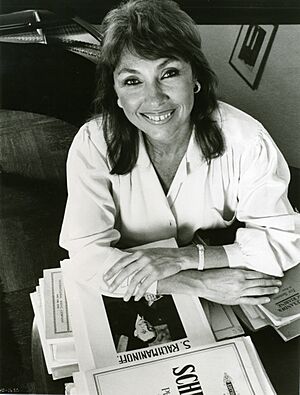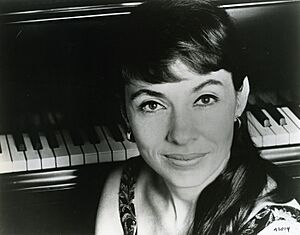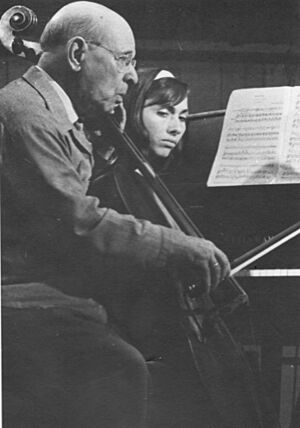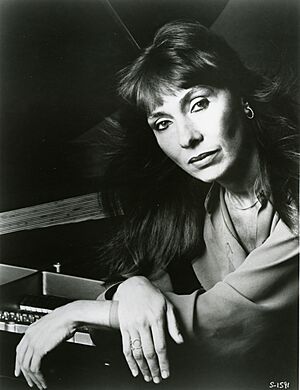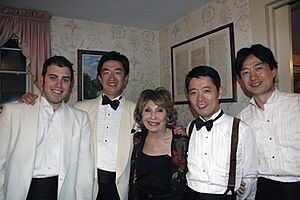Ruth Laredo facts for kids
Ruth Laredo (born November 20, 1937 – died May 25, 2005) was a famous American classical pianist.
She became well-known in the 1970s for being the first to record all 10 sonatas by Scriabin. She also recorded all the solo piano music by Rachmaninoff. Her recordings of Ravel's music were also very popular. For over 16 years, she hosted a special concert series called “Concerts with Commentary” at the Metropolitan Museum of Art. People often called her “America's First Lady of the Piano.”
Contents
Ruth Laredo's Life Story
Ruth Meckler was born on November 20, 1937, in Detroit, Michigan. She was the older of two daughters. Her mother, Miriam Meckler-Horowitz, taught piano. Her father, Ben Meckler, was an English teacher. When Ruth was only two years old, she could play "God Bless America" on her mother's piano, even though no one had taught her.
When Ruth was eight, her mother took her to a concert by Vladimir Horowitz in Detroit. After the concert, Ruth decided she wanted to be a concert pianist. Horowitz played music by Scriabin. Ruth loved this music so much that she became passionate about Scriabin and other Russian composers, like Rachmaninoff, for her whole life.
In 1960, Ruth moved to New York City. She married Jaime Laredo, a violinist from Bolivia. She had met him at the Curtis Institute of Music in Philadelphia. They often performed together until they divorced in 1974. They had a daughter named Jennifer in 1969. Jennifer Laredo Watkins now lives in London and is married to Paul Watkins, a conductor.
While she was pregnant and after her daughter was born, Ruth Laredo toured less with her husband. She really wanted to record Scriabin's music. She asked many record companies if she could record all ten of his sonatas. Alan Silver from the Connoisseur Society agreed to take a chance on her. At first, it was only for one record.
After her first recording was a success, Connoisseur asked her to record the other seven sonatas. This made Laredo the first pianist to record all of Scriabin's piano sonatas. This big achievement helped her become famous as a solo artist.
Laredo explained in her book, The Ruth Laredo Becoming a Musician Book, that finding a special type of music to play was a different way to start a solo career. Usually, musicians try to win competitions. But Laredo only won the Young Concert Artists International Auditions. She didn't win other big competitions.
When her daughter was older, Laredo started touring with her husband again. But then he wanted a divorce. The divorce was final in 1974. This was a difficult time for Laredo. She took a teaching job at Yale University. She also accepted an offer from Thomas Z. Shepard at CBS Masterworks. He was impressed by her Scriabin recordings. He asked her to record all of Rachmaninoff's solo piano music.
Laredo said this project saved her life. She made the Rachmaninoff recordings from 1974 to 1979. With these recordings, her solo career really took off.
After her important recordings, the music publisher C. F. Peters asked Ruth Laredo to create a new, accurate edition of Rachmaninoff's complete 24 Preludes. These were published in 1981, 1985, and 1991. Laredo believed that many of the notes in common Rachmaninoff editions were not what the composer originally wrote. She studied original papers in the Library of Congress and the Rachmaninoff archive. She also saw them in the Glinka Museum during her 1989 tour to Russia. Her studies confirmed her suspicions. Her new editions were much closer to Rachmaninoff's original music.
Laredo wrote articles for Piano Today and Keyboard Classics magazines. She also hosted shows for NPR and the New York classical radio station WQXR.
In 2000, Laredo appeared in a scene in Woody Allen's movie Small Time Crooks. In the movie, Hugh Grant's character tries to impress Tracey Ullman's character by taking her to a piano concert where Ruth Laredo plays Rachmaninoff.
Laredo was known for wearing beautiful gowns on stage. Many fashion magazines showed her outfits. She was often seen riding her bicycle or jogging in Manhattan's Upper West Side, where she lived. She sometimes listened to music by Phil Collins or the rock band Genesis.
Ruth Laredo cared deeply about her Jewish tradition. In one of her “Concerts with Commentary,” she talked about Felix Mendelssohn. She explained how important his Jewish background was. She said that Mendelssohn's father decided to become Protestant so his son could be accepted in the music world in Germany.
Ruth Laredo died peacefully in her sleep on May 25, 2005. She had been diagnosed with ovarian cancer four years earlier, but it did not stop her from performing. She is buried in Kensico Cemetery, Valhalla, New York. Her grave is only a few meters from Sergei Rachmaninoff's grave. He was a very important composer in her life. At her funeral on May 31, 2005, two of her close friends performed. They were Wei Gang Li from the Shanghai Quartet and Courtenay Budd. Ruth Laredo had given her last “Concert with Commentary” with them on May 6, 2005.
On May 18, 2006, her daughter Jennifer organized a memorial concert for her. It was held at the Metropolitan Museum of Art in New York City. Many famous musicians performed. Courtenay Budd sang Ruth Laredo's favorite song, Franz Schubert's An die Musik. Jennifer chose the title of this song for her mother's gravestone.
In 2007, the Ruth Laredo Memorial Prize was created for the Young Concert Artists International Auditions. Her family, friends, and fans helped fund it. Laredo had won this award in 1962. Later, she often served as a judge for the auditions. Some winners of this prize include Benjamin Moser and George Li, both pianists.
Learning Music
Ruth Laredo's mother, Miriam Meckler, was a piano teacher. She taught Ruth first. In 1947, when Ruth needed more serious training, her mother sent her to Edward Bredshall. Bredshall had studied in Paris and was known for his good teaching methods. Ruth studied with him for four years. He introduced her to music by other Russian composers, like Prokofiev, Stravinsky, and Kabalevsky.
Because she loved Russian music, she later worked with Mischa Kottler. He was a Russian immigrant who also taught other musicians.
From 1951 to 1955, Laredo went to Mumford High School in Detroit. During summer breaks, she enjoyed workshops in Stockbridge, Massachusetts. After graduating in 1955, she began studying with Rudolf Serkin at the Curtis Institute of Music in Philadelphia. She had met Serkin in 1954. Serkin told her at her audition, “I can see that you play like a tiger!” He accepted her as one of only four students.
Rudolf Serkin was a very famous artist. He was known for being completely dedicated to music and staying true to the composer's ideas. At first, he didn't like Laredo's love for Russian composers. He preferred composers like Mozart, Beethoven, Schubert, and Brahms. Even so, Ruth Laredo later became famous for her Scriabin and Rachmaninoff recordings.
Ruth Laredo spent many summers at the Marlboro Music School and Festival in Vermont. Rudolf Serkin helped start this festival. There, she continued studying with Serkin. The cellist Pablo Casals also coached her in chamber music. Other students there included famous musicians like Murray Perahia and Yo-Yo Ma.
Ruth Laredo graduated in 1960. She received a diploma from the Curtis Institute of Music and a degree from the University of Pennsylvania. Her graduation was part of a celebration for the American composer Samuel Barber's fiftieth birthday. By chance, she had prepared his Sonata in E-flat minor for her graduation concert. So, she became part of the celebration. Barber was in the audience. After the concert, he congratulated her warmly and wrote “Brava, bravissima” on her music.
Sharing Her Music
At the Curtis Institute of Music and the Meadowmount School of Music summer festival, Ruth Laredo was chosen to be the piano accompanist for students of famous teachers. These students included future stars like Pinchas Zukerman and Itzhak Perlman.
Ruth Laredo taught at several universities, including Kent State University, Yale University, the Curtis Institute of Music, and the Manhattan School of Music. She also gave special teaching sessions called master classes at many other schools. She held a special teaching position at Florida State University. Some of her students became famous, like art critic Michael Kimmelman and pianist Oliver Schnyder.
Laredo was a judge for many music competitions. These included the Young Concert Artists International Auditions and the Naumburg Foundation Competition. In 2004, she was a judge for the International Piano-e-Competition. The competition director said after her death, “She was so feisty and opinionated, a powerful personality.”
Amazing Performances
Ruth Laredo first performed on stage as a little girl in Detroit. When she was 11, she gave her first solo concert. She also played with the Detroit Symphony Orchestra for the first time.
For the first ten years of her career, she often played piano for her husband, Jaime Laredo. At the same time, she tried to become a solo performer. In 1962, she played with the American Symphony Orchestra in Carnegie Hall. But this debut didn't get much attention. It took some time for her to be recognized as a solo artist.
She helped start the Music from Marlboro Concerts. In 1965, she went on their first tour, which included a visit to Israel. She played a concerto for three pianos with Rudolf and Peter Serkin. She also performed in the very first "Music from Marlboro Concert" at Carnegie Hall.
Her solo career got a big boost in 1974. She made her debut at Avery Fisher Hall in New York's Lincoln Center. She played Maurice Ravel's Piano Concerto in G major with the New York Philharmonic. The audience and critics loved her performance. In 1976, Young Concert Artists presented her first solo concert at Alice Tully Hall. She played pieces by Beethoven, Scriabin, Rachmaninoff, and Ravel. Ravel's “La Valse” became one of her most famous pieces. As an extra song, she played Gershwin's Second Piano Prelude. In 1981, she gave her first solo concert at Carnegie Hall. It was called “Homage to Rachmaninoff.”
In 1988, Laredo took part in a celebration for the 135th anniversary of the first Steinway piano. This concert also celebrated the 500,000th piano made by Steinway. Twenty-seven famous pianists performed. Laredo played Rachmaninoff's Prelude and a piece by Robert Schumann.
Besides New York City and Detroit, Laredo performed in many other cities across the US. She also played at numerous music festivals. She toured Europe and Japan in 1976/1977 and again in 1979. Her tour to Russia and Ukraine in 1989 was very special. An American coming to Russia to play Russian composers' music was amazing. She played in the same room in the Moscow Conservatory where Rachmaninoff had played. Laredo received a very warm welcome, and her concerts were sold out. In the Glinka Museum in Moscow, she saw Rachmaninoff's original music papers.
Ruth Laredo played with many famous orchestras, including the New York Philharmonic, the Detroit Symphony Orchestra, and the Philadelphia. In 1993, she performed in Warsaw with the Warsaw Philharmonic Orchestra. This concert was broadcast on TV across Europe. Then, she toured the US with the orchestra, ending with a concert in Carnegie Hall.
In the 1988/1989 season, she started her “Concerts with Commentary” series at the Metropolitan Museum of Art. This series ran for 17 seasons until her last concert on May 6, 2005. The programs became very popular, and she performed them in other US cities.
In these concerts, she discussed works by composers like Brahms, Chopin, Rachmaninoff, and Ravel before playing them. Her final concert was part of a series called “The Russian Spirit.”
On September 13, 2001, just two days after the terrorist attacks on the World Trade Center, Ruth Laredo celebrated the 25th anniversary of her debut at Alice Tully Hall. This was the opening concert of Lincoln Center's 2001 season. Before the concert, she told the audience why she hadn't canceled: “It was important for me to play. Great music gives us spiritual sustenance and gives us hope. It is in that spirit that I play tonight.”
In September 2004, the Russian Ministry of Culture invited Laredo to a festival in St. Petersburg. She played chamber music and solo concerts. She also gave a master class for Russian students.
She was known for her strong commitment to chamber music. She believed soloists needed this experience to prepare for playing with big orchestras. Laredo often worked with the Shanghai Quartet, who called her “the fifth member of the Shanghai Quartet.” She also played with many other string quartets and chamber orchestras. She toured every season with the flutist Paula Robison as the “Paula and Ruth” duo.
Ruth Laredo also played modern music, especially early in her career at Marlboro. She played the world premiere of Peter Martins's work called Waltzes with the New York City Ballet in 1983/1984. Her music included works by Franz Liszt, Arnold Schoenberg, and Béla Bartók.
In 1994, Laredo played with jazz pianist Marian McPartland. From 1996, she performed with McPartland and Dick Hyman in programs called Three Piano Crossover.
In her last years, she played fewer concerts as a soloist with orchestras. But she was happy performing a mix of solo and chamber concerts.
Laredo did not like the growing trend in the US of recording live concerts for broadcast. She preferred the European way of recording music in radio studios for later broadcast.
Her Famous Recordings
In 1967, Ruth Laredo recorded a popular album of piano music by the French composer Maurice Ravel. Ravel's music is known for being very challenging to play.
In 1970, Laredo made her famous first recordings of Scriabin's 10 sonatas. She recorded them on three records for Connoisseur Society. These were re-released later on CDs. She made the recordings in St. Paul's Chapel at Columbia University in New York City. She used a Baldwin grand piano. When her Scriabin records came out, not much of his music was available. Laredo's recordings helped make his music more popular in the US. Laredo said, "I was kind of a crusader for his music."
From 1974 to 1981, she recorded all of Rachmaninoff's solo piano music on seven records for CBS Masterworks. No pianist had ever tried to record all of these works before. At this time, it was rare to see a female piano soloist, especially playing Rachmaninoff's difficult and powerful music. There were only a few others, like Gina Bachauer and Alicia de Larrocha. The New York Daily News then called her “America's First Lady of the Piano.” Many others later used this name. Laredo initially didn't like it because she felt it was sexist. She wanted to be known as a pianist, not a “woman pianist.” Later, she accepted the title and even used it in her book and on her website.
Getting ready to record Rachmaninoff's solo piano works was very tiring. Laredo said she understood why some pieces had never been played before: they were simply too hard. Rachmaninoff was very tall, with large hands. He wrote many of his pieces for himself. People wondered how the tiny 5-foot-1-inch Laredo could play Rachmaninoff's pieces, some of which needed her to stretch her hands across 11 keys. After practicing Rachmaninoff's music, she often needed hand massages.
Ruth Laredo also recorded more than 20 other albums. These featured music by composers like Bach, Beethoven, Brahms, Chopin, Mozart, Ravel, and Tchaikovsky. She also recorded music by American composers. Her recording of Stravinsky's The Rite of Spring for two pianos, with James Tocco, was especially praised.
Laredo made her last recordings in 1999 with the Shanghai Quartet. They called her “the fifth member of the Shanghai Quartet.” These recordings were released in 2000.
Her last radio program was with jazz pianist Marian McPartland for NPR on February 19, 2004.
Awards and Honors
- Winner of the Gabrilowitsch scholarship (1948/49)
- Winner of the Young Concert Artists International Auditions (1962)
- Year's Best Recording Award from Stereo Review and Saturday Review (for Ravel recordings; 1968)
- Year's Best Recording Award from Saturday Review and High Fidelity (for Scriabin recordings; 1970)
- Best of the Month from Stereo Review (for Scriabin recordings; 1970)
- Musician of the Month from High Fidelity/Musical America (1974)
- Nomination for the Grammy Award 1976 (for Ravel Trio)
- Best of the Month from Stereo Review (for Rachmaninoff recordings; 1979)
- Best Keyboard Artist Award from Record World Magazine (for Rachmaninoff recordings; 1979)
- Nomination for the Grammy Award 1981 (for Rachmaninoff recordings)
- Selected as one of five pianists for the 90-year anniversary celebration of the Carnegie Hall (1981)
- Nomination for the Grammy Award 1983 (for Barber recordings)
- Honorary Member of the Sigma Alpha Iota International Music Fraternity (1983)
- Distinguished Service to Music in America Award from the Music Teachers National Association (1989)
- Music in Humanity Award at the Music Festival in Mount Gretna, Pennsylvania (1994)
- Best of the Year from the Audiophile Audition Magazine (for Scriabin Sonatas new edition; 1997)
List of Recordings
- Mozart/Bach. Music from Marlboro; Mozart: Concerto in E-flat for two Pianos; Bach: Concerto in C major for three Pianos, Concerto in D minor for three Pianos; Marlboro Festival Orchestra. LP, CBS Masterworks ML 6247, 1964
- Bach. Brandenburg Concerto No. 1, Brandenburg Concerto No. 2, Brandenburg Concerto No. 3; Orchestral Suite No. 1; Marlboro Festival Orchestra: Pablo Casals. CD, Sony Classical SMK 46253, 1990; recorded 1964, 1965, 1966
- Bach. Brandenburg Concerto No. 4, Brandenburg Concerto No. 5, Brandenburg Concerto No. 6; Orchestral Suite No. 4; Marlboro Festival Orchestra: Pablo Casals. CD, Sony Classical SMK 46254, 1990; recorded 1964, 1966
- Bach. Goldberg Variations, BWV 1087; Orchestral Suite No. 2, Orchestral Suite No. 3; Marlboro Festival Orchestra: Pablo Casals. CD, Sony Classical SMK 45892, 1990; recorded 1976, 1966
- Ravel. Gaspard de la Nuit, Valses Nobles et Sentimentales, La Valse. LP, Connoisseur Society CS-2005, 1968
- Scriabin. The Complete Piano Sonatas, Sonata No. 1, Etude, Op. 2, No. 1; Sonata No. 2; Eight Etudes, Op. 42; Sonata No. 3; Sonata No. 4; Sonata No. 5; Sonata No. 6; Désir, Op. 57, No. 1; Caresse dansée, Op. 57, No. 2; Sonata No. 7; Sonata No. 8; Sonata No. 9; Sonata No. 10; Vers la Flamme, Op. 72. 2 CDs, Nonesuch 5973035-2, 1996 (new edition of 3 LPs Connoisseur Society, 1970/Nonesuch, 1984)
- Robert Schumann. Music for piano and violin; Ruth Laredo (piano), Jaime Laredo (violin); Sonata No. 1; Sonata No. 2; Intermezzo from F.A.E. Sonata. LP, Desto DC 6442, 1979; recorded 1970
- Laderman/Siegmeister. Ezra Laderman: Duo for Violin and Piano; Elie Siegmeister: Sonata No. 2; Jaime Laredo (violin), Ruth Laredo (piano). Desto Records LP DC 7125, 1971
- Scriabin. 24 Preludes, Op. 11; 5 Preludes, Op. 74; Poem, Op. 32, No. 1. CD, Phoenix USA PHCD 114, 1990 (new edition of LP Desto DC 7145, 1972)
- Rorem/Kirchner. Ned Rorem: Day Music, Leon Kirchner: Sonata concertante; Jaime Loredo (violin), Ruth Laredo (piano). LP, Desto DC 7151, 1973
- Rorem. Day Music: Jaime Laredo (violin), Ruth Laredo (piano); Night Music: Earl Carlyss (violin), Ann Schein (piano). CD, Phoenix USA PHCD123, 1991 (Day Music previously published on LP Desto DC 7151, 1973; Night Music on LP Desto DC 7174, 1974)
- Scriabin. Greatest Hits; Ruth Laredo plays Etude, Op. 2, No. 1; Sonata No. 4, Op. 30; Etudes, Op. 42, No. 3 and No. 4; Vers la Flamme, Op. 72; Sonata No. 5, Op. 53. LP, Connoisseur Society CS-2046, 1973
- Ravel. Music from Marlboro, The Marlboro Music Festival; Trio for Violin, Cello and Piano: Jaime Laredo (violin), Ruth Laredo (piano), Jeffrey Solow (cello); Sonata for Violin and Cello: Jaime Laredo (violin), Leslie Parnas (cello). LP, CBS Masterworks M 33529, 1973
- Kirchner/Copland/Ives/Lees. Music for Violin and Piano; Leon Kirchner: Sonata Concertante (Jaime Laredo, violin; Ruth Laredo, piano); Aaron Copland: Sonata for Violin and Piano; Charles Ives: Sonata No. 4 for Violin and Piano; Benjamin Lees: Sonata No. 2. CD, Phoenix USA PHCD 136, 1997
- Rachmaninoff. The Complete Solo Piano Music, Vol. 1; Fantasy Pieces, Op. 3; Salon Pieces, Op. 10; Moments Musicaux, Op. 16. CD, Sony Classical SMK 48468, 1993 (new edition on 5 CDs of The Complete Works for Solo Piano on 7 LPs from CBS Masterworks, 1974–1981)
- Rachmaninoff. The Complete Solo Piano Music, Vol. 2; Piano Transcriptions; Chopin Variations. CD, Sony Classical SMK 48469, 1993 (new edition on 5 CDs of The Complete Works for Solo Piano on 7 LPs from CBS Masterworks, 1974–1981)
- Rachmaninoff. The Complete Solo Piano Music, Vol. 3; Sonatas No. 1, Op. 28 and No. 2, Op. 36; Corelli Variations. CD, Sony Classical SMK 48470, 1993 (new edition on 5 CDs of The Complete Works for Solo Piano on 7 LPs from CBS Masterworks, 1974–1981)
- Rachmaninoff. The Complete Solo Piano Music, Vol. 4; Preludes Op. 23 and Op. 32. CD, Sony Classical SMK 48471, 1993 (new edition on 5 CDs of The Complete Works for Solo Piano on 7 LPs from CBS Masterworks, 1974–1981)
- Rachmaninoff. The Complete Solo Piano Music, Vol. 5; Etudes-Tableaux, Op. 33 and Op. 39; Fragments; Lilacs; Daisies; Oriental Sketch; Two Fantasy Pieces. CD, Sony Classical SMK 48472, 1993 (new edition on 5 CDs of The Complete Works for Solo Piano on 7 LPs from CBS Masterworks, 1974–1981)
- Rachmaninoff. Romantic Piano Pieces: Morceaux de fantaisie, Op. 3; Morceaux de salon, Op. 10; Moments musicaux, Op. 16; Preludes, Op. 23; Preludes, Op. 32; Etudes-Tableaux, Op. 33 and Op. 39. CD, Sony Classical, SMK 89950, 2002 (collection of previously published material, 1974–1977)
- Rachmaninoff/Debussy/Scriabin/Prokofiev. Recital; Rachmaninoff: Prelude in C-sharp minor; Debussy: Feu d’artifice, Bruyères, La fille aux cheveux de lin, Reflets dans l'eau; Scriabin: Etude in C-sharp minor; Poem; Sonata No. 9; Prokofiev: Sonata No. 3. CD, Connoisseur Society 30CD-3020, 1980
- Debussy/Scriabin/Rachmaninoff. Essential Piano Library, The Student's Essential Classics; Ruth Laredo plays Debussy, The Girl with the Flaxen Hair, Reflections in the Water, Fireworks; Scriabin, Etude in C-sharp minor; Rachmaninoff, Prelude in C-sharp minor. 2 LPs Baldwin Piano Artists BDW-700/701, 1981
- Scriabin/Prokofiev/Barber. Essential Piano Library, Masters Perform Master Works. LP, Baldwin Piano Artists BDW-805, 1981
- Ravel. Miroirs, La Valse, Sonatine, Prelude in A major, Menuet sur le nom d'Haydn. CD, Sanctuary, 1998 (new edition of LP CBS Masterworks M 36734, 1982)
- Barber. Piano Sonata, Op. 26; Souvenirs, Op. 28; Nocturne, Op. 33. CD, Sanctuary, 1998 (new edition of LP Nonesuch D 79032, 1982)
- Chopin. Mazurkas, Op. 6, Nos. 2 and 3; Op. 24, No. 2; Op. 33, No. 4; Op. 56, No. 2; Op. 63, No. 3; Waltzes, Op. 34, Nos. 1 and 2; Op. 42; Op. 69, No. 1; Op. 69, No. 2; Etude, Op. 25, No. 4; Nocturne, Op. 15, No. 1; Scherzo, Op. 20. CD, Sanctuary, 1998 (new edition of LP Nonesuch 71450, 1987; recorded 1982/1985)
- Tchaikovsky. The Seasons, Op. 37a; Polka de Salon, Op. 9, No. 2; Mazurka de Salon, Op. 9, No. 3; Humoresque, Op. 10, No. 2; Natha-Valse, Op. 51, No. 4. CD, Sanctuary, 1998 (new edition of LP Nonesuch Digital Stereo 79119, 1985)
- Fauré/Lili Boulanger/Ravel/Poulenc. French Masterpieces for flute and piano, Ruth Laredo (piano), Paula Robison (flute); Gabriel Fauré: Sonata in A major; Lili Boulanger: Nocturne; Maurice Ravel: Pièce en forme de Habanera; Francis Poulenc: Sonata. CD, Pergola, 2006 (new edition of CD Musical Heritage Society 2003 resp. LP Amerco 1991/1992; recorded in 1985)
- Beethoven. Sonatas No. 23 (Appassionata), No. 26 (Les Adieux), No. 3 and No. 20. CD, Second Hearing GS 9007, 1986; recorded live
- Ravel. Pièces pour 2 pianos, Ruth Laredo, Jacques Rouvier; Bolero, Mother Goose Suite, Sites Auriculaires, Frontispièce, La Valse. CD, Denon 33C37-7907, 1986
- Albéniz/Falla. Isaac Albéniz: Songs of Spain, Suite Española; Manuel de Falla: Three Dances from The Three-Cornered Hat, Suite from El Amor Brujo. CD, MCA Classics MCAD-6265, 1988
- Bach/Mozart/Beethoven/Chopin/Debussy/Robert Schumann/Prokofiev. My First Recital; Bach: Prelude No. 1 in C, Two-Part Invention No. 1 in C, Two-Part Invention No. 4 in d, Two-Part Invention No. 8 in F; Mozart: Fantasia in d, Sonata in C; Beethoven: Für Elise; Sonata No. 20 in G; Chopin: Waltz in D, Waltz in A, Grande Valse Brillante in E; Debussy: The Girl With the Flaxen Hair; Clair de Lune; Schumann: Kinderszenen (From Foreign Lands and People, A Curious Story, An Important Event, Dreaming); Prokofiev: March from Peter and the Wolf. CD, ESS.A.Y CD1006, 1990
- Bach/Mozart/Beethoven/Robert Schumann/Debussy/Brahms/Chopin/Tchaikovsky/Khachaturian. My Second Recital; Bach: Jesu, Joy of Man's Desiring; Mozart: Rondo alla Turca; Beethoven: Sonata No. 24 in F-sharp major, Adagio Cantabile, Allegro Vivace; Schumann: Arabesque; Debussy: Sarabande; Brahms: Waltz, Op. 39, No. 2 in E major, Waltz, Op. 39, No. 3 in G-sharp minor, Waltz, Op. 39, No. 4 in E minor, Waltz, Op. 39, No. 5 in E major, Waltz, Op. 39, No. 15 in A-flat major; Waltz in Intermezzo in E-flat major; Chopin: Mazurka in F-sharp minor; Waltz in C-sharp minor; Nocturne in F-sharp minor; Tchaikovsky: Humoresque, Natha-Valse, Barcarolle; Khachaturian: Toccata. CD, ESS.A.Y CD1026, 1991
- Stravinsky/Rachmaninoff. Music from the Great Lakes Chamber Music Festival, Music for Two Pianos; James Tocco and Ruth Laredo; Stravinsky: Le Sacre du Printemps; Rachmaninoff: Suite No. 2 for 2 Pianos. CD, Gasparo GSCD-313, 1996; recorded 1995
- Rachmaninoff. Piano Concerto No. 3; Morceaux de salon Op. 10, Nos. 2, 3 and 7; Vocalise, Op. 34, No. 14; Prelude, Op. 23, No. 5, Prelude, Op. 32, Nos. 5, 1, 7, 8 and 12; Symphonic Dances, Op. 45, Nos. 1, 2 and 3; Etudes-Tableaux, Op. 39, Nos. 2, 5 and 6; Rhapsody on a Theme of Paganini, Op. 43. 2 CDs, Sony Classical SB2K 64 343, 1996
- Beethoven. 3 Sonatas; Sonata No. 23, Op. 57 (Appassionata); No. 17, Op. 31; No. 2 (Tempest); No. 26, Op. 81a (Les Adieux); Bagatelle for Piano in A minor (Für Elise); Bagatelle in B major. CD, Connoisseur Society CD-4210, 1997
- Mendelssohn/Robert Schumann/Clara Schumann/Brahms. Such Good Friends; Felix Mendelssohn: Introduction and Rondo capriccioso, Op. 14; Robert Schumann: Eight Fantasy Pieces, Op. 12; Clara Schumann: Romance, Op. 11, No. 1; Johannes Brahms: Intermezzi, Op. 117, Nos. 1, 2 and 3; Pieces for Piano, Op. 118, No. 2, 119, No. 1; Fantasia, Op. 116, No. 4. CD, Open Mike M 4022 (or Sanctuary CD 3001), 1999, recorded 1998
- Brahms. Piano Quartets No. 1, Op. 25, No. 2, Op. 26, No. 3, Op. 60, The Shanghai Quartet and Ruth Laredo (piano). 2 CDs, Arabesque Z6740-2, 2000; recorded April 1999
- Rorem. Chamber Music, Great Lakes Chamber Music Festival; Day Music: Ruth Laredo (piano), Philip Setzer (violin); War Scenes: Kurt Ollmann (baritone), Ned Rorem (piano); End of Summer: Elm City Ensemble. CD, Newport Classic NPD 85663, 2000; recorded June 1999
Images for kids
See also
 In Spanish: Ruth Laredo para niños
In Spanish: Ruth Laredo para niños


